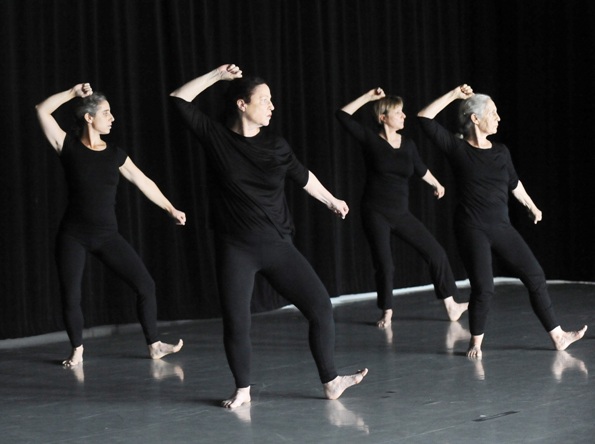
Two young dancers stand in the wide space of the studio. A black curtain covers the walls, transforming the well-lit studio into a large black box; the audience sits on folding metal chairs on bleachers. The women are dressed in black leggings and T-shirts, their hair pulled back. There will be no set, props, costume changes or lighting effects during this performance. There will be no music.
A slender white-haired woman sets a metronome ticking, and then counts in a low voice: ahat, shtayim, shalosh, arba (Hebrew: one, two, three, four). The women begin to move, a communication direct and pure, a language of feelings, thought and associations distilled into movement.
From the first moments of movement until the last seconds of stillness, the Noa Eshkol Chamber Dance Group performance last night, hosted by the Batsheva Dance Company in the Varda Studio at Suzanne Dellal, was beautiful and inspiring. A look at the art of Noa Eshkol and her legacy, performed by Racheli Nul-Kahana, Ruti Sela, Hamutal Peled, Mor Bashan and Noga Goral.
Eshkol, co-creator of the Eshkol-Wachman Movement Notation, founded the Chamber Dance Group in 1954. Today the group is guided by Racheli Nul-Kahana and Ruti Sela, who studied and worked with Eshkol. Introducing the evening, Racheli said that Eshkol considered the notation language a thinking tool, and used it to compose movement. For the un-initiated, seeing a page of Eshkol-Wachman Movement Notation can be a daunting experience, and Eshkol’s philosophy and methods sound cerebral and abstract, perhaps somewhat distancing. Yet one need not become an expert in Eshkol’s methods to experience the performance, or appreciate her influence.
The body itself is never an abstraction. Blood, breath and movement conjure worlds of images, associations and emotions. Eshkol’s approach is cerebral, but emotions are cerebral too: the heart is, after all, a muscle, and the brain is where we feel.
The performance was followed by a discussion with the dancers. It was not surprising that one of the first questions asked was why Eshkol did not want to use music in her dances. Racheli Nul-Kahana replied, “Noa felt that music has a powerful effect on our senses and she wanted to see what happens in its absence. She wanted to try things, she was not afraid to experiment.”
In the absence of musical cues, one audience member was curious to know what goes on in the dancers’ minds as they perform. Ruti Sela (who counted out the opening for each piece) said, “You learn the dance with the counting, it is very complex because it changes,” yet once the dancers know it, she added, “it becomes a song and you sing it in your head…Her [Eshkol’s] world of imagery was crazy. Some of the images were harsh, it was all mixed together and it all influenced the dance. She would tell me: tell a story, don’t dance like a block of wood.”
The expressive quality of the dancers is a powerful element of the performance; all five are mesmerizing to watch, creating a unique experience of concentration on the body and its movement. The composition of the group with its wide range of ages is unusual for the world of dance. Nul-Kahana and Sela demonstrate that wisdom accrues in the body as well as the mind and beauty is beyond numbers. In an era of fascination with the new, when new becomes passé at an ever increasing pace, it is intriguing to view the work of a group dedicated to preserving and teaching the method and repertoire of a creator and mentor such as Eshkol. Some insight to this mystery; may be found in Racheli Nul-Kahan’s words: “Something happens when you perform a dance. Dancing is not counting or raising your leg. It is a way of being…something that happens in moments of grace. It is for those moments that you do it.”
Future performances of the Noa Eshkol Chamber Dance Group will take place on February 3rd at 14:30, and February 4th at 20:00, in the Varda Studio, Suzanne Dellal Centre. Tickets may be ordered online, or call: 03- 5171471.
Noa Eshkol’s work is currently explored in two exhibitions, at the Israel Museum in Jerusalem and the Center for Contemporary Art in Tel Aviv.
Sharon Lockheart/Noa Eshkol, curated by Talia Amar, at the Israel Museum, includes a five-channel film installation Five Dances and Nine Wall Carpets by Noa Eshkol (2011); and photographs created by American artist Sharon Lockheart in collaboration with the Noa Eshkol Foundation for Movement Notation. The exhibition will be open through April 30, 2012.
The exhibit at the Center for Contemporary Art, curated by Sergio Edelsztein, has several components, with open classes, open rehearsals of the Noa Eshkol Chamber Dance Group, lectures, and film screenings. The exhibit and activities will be open through February 12, 2012 at the Center for Contemporary Art, 5 Kalisher Street. A complete schedule is available on the website.

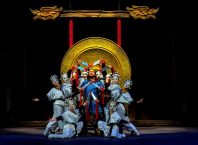

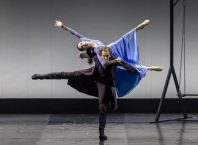
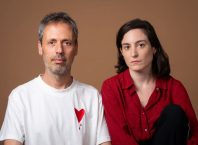
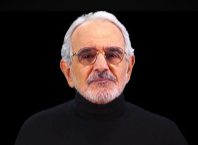
[…] was hosted by the Batsheva Dance Company, and performed in the Varda Studio at Suzanne Dellal. Read more about the performance here. Visit the Center for Contemporary Art, 5 Kalisher Street, Tel Aviv. Tel: 03-5106111. Opening hours: […]
Comments are closed.